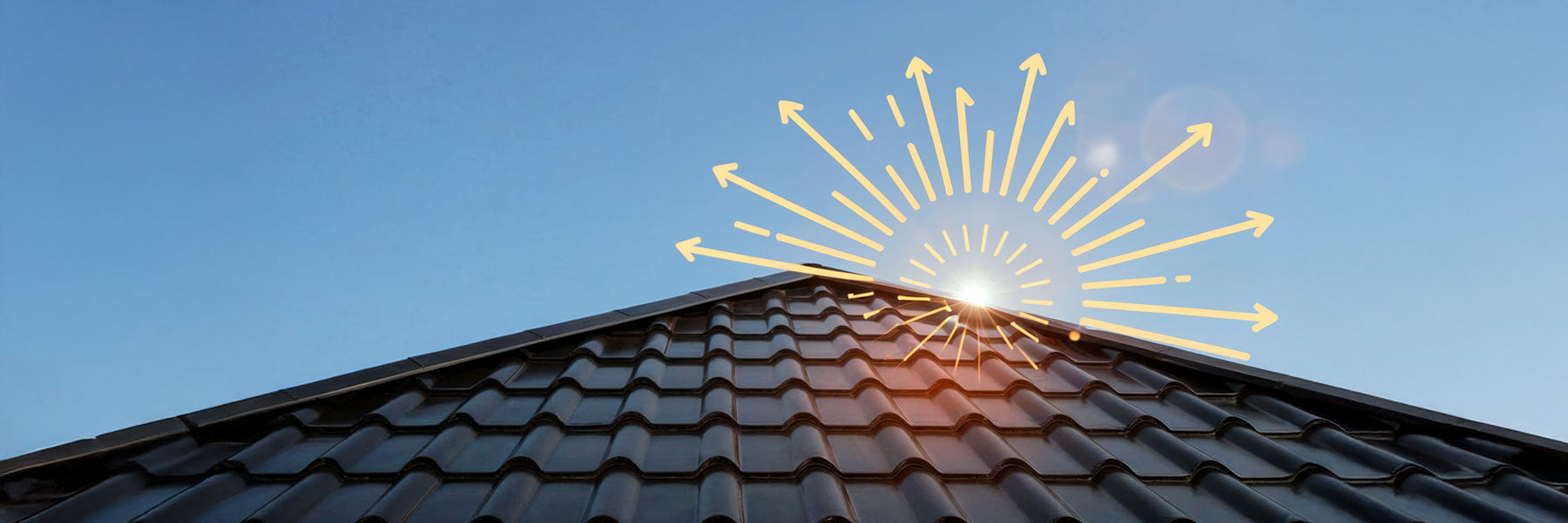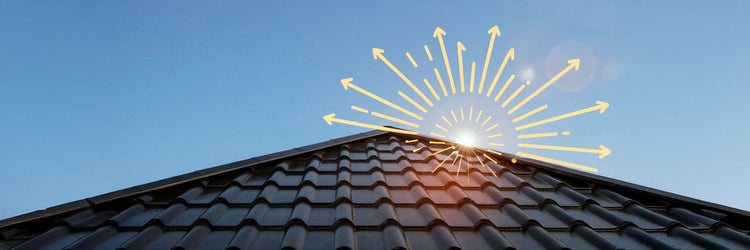Do Metal Roofs Make a House Hotter?
The majority of homeowners think that metal roofs make their houses much hotter, especially in the summer. That is just not the case. Actually, metal roofs can make your house cooler than conventional asphalt shingles. In this article, we examine some articles, studies, and industry websites on metal roofing and how it impacts house temperature.
How Metal Roofs Impact Temperature
Metal roofs have several features that make them cool:
- Reflectivity: Metal roofs are more reflective and absorb less heat than asphalt shingles. This is especially true for lighter-coloured metal roofs.
- Heat-Shedding Ability: Metal roofs have a high heat-shedding ability, in that they release any heat that they absorb quickly.
- Low Thermal Mass: Therefore, metal roofs don't retain heat like asphalt shingles do, which is to say they cool down relatively quickly once the sun sets.
- Composition: Metal roofs are typically painted with reflective paint or coated with reflective coatings that help reflect sunlight, thereby reducing the amount of heat absorbed by the roof. They also typically include insulation layers that help regulate temperature by preventing the transfer of heat.
- High Heat Conductivity: Surprisingly, high heat conductivity of metal roofing has benefits. Their capacity to lose retained heat, especially during cooler nighttime hours, prevents heat accumulation.
Factors Influencing Heat Absorption
While metal roofing has the tendency to keep homes cool, there are certain factors influencing the degree of heat absorption:
- Colour: Darker-coloured metal roofing absorbs more heat than lighter-coloured metal roofing.
- Finish: Some metal roof finishes are designed to be more reflective, which reduces heat absorption even further. Galvalume and galvanized steel, for example, are reflective and shed heat better.
- Cool Colours: In addition to the overall roof colour, "cool colours" help with heat absorption. These colours have special coatings that are highly reflective in the near-infrared portion of the solar spectrum, which also inhibits heat gain.
Optimizing Your Metal Roof for Cooling
Ventilation and insulation of the attic are critical elements in managing your home's temperature, regardless of the type of roofing.
- Insulation: Proper insulation in the attic is the key to preventing the flow of heat from the roof to the living space. Spray foam, rigid foam board, or reflective foil barriers can effectively create a thermal barrier.
- Ventilation: Adequate attic ventilation allows a path for hot air to ventilate and cool air to enter, also reducing heat accumulation. This can be accomplished through various types of vents, such as ridge vents, soffit vents, and even wind-powered turbine vents.
Metal Roofs vs. Other Roofing Materials
So, like, if you're comparing asphalt shingles and metal roofs, metal ones totally outshine them when it comes to heat reflection and energy efficiency. Asphalt shingles absorb a lot of heat, which can make the interior of your property 20 to 25 degrees hotter. But metal roofs? They can actually be 100 degrees cooler on the surface compared to those asphalt shingles.
Metal roofing panels also reflect more sunlight since they have a higher solar reflective index (SRI). The higher the SRI, the more effectively they are able to reflect solar energy away from their surface. They do this by utilizing less cooling energy efficiently.
In addition, metal roofs dissipate heat quickly and do not add to the urban heat island effect (UHI) as much as asphalt shingles, as they retain the heat for longer durations.
While metal roofs cost more initially, they are more durable and longer lasting, requiring less upkeep and being rarely replaced like asphalt shingles.
Ways to Further Minimize Heat Gain from a Metal Roof
While metal roofs already reflect well, there are additional ways to maximize their cooling effect:
- Cool Roof Coatings: The use of reflective cool roof coatings on the metal surface can contribute to its reflectivity and heat-shedding ability. Cool roof coatings can also help in extending the life of the roof by reducing temperature-stress.
- Radiant Barriers: Installing radiant barriers under the metal roof can reflect radiant heat away from the roof and back into the atmosphere.
- Shade: Trees planted around the house can provide shade and reduce the amount of direct sunlight reaching the roof.
- Solar Panels: Installing solar panels on a metal roof can provide shade and reduce heat absorption. If installing solar panels, consider leaving an air gap between the panels and the roof to allow for air circulation and prevent heat buildup.
Metal Roofs and Solar Panels
If you're considering having a solar energy system installed on your house, if you have a metal roof, that can definitely be beneficial. New metal roofs are highly compatible with solar panels because they're strong and durable, so they can definitely support the weight of multiple panels and racks.
Types of Metal Roofs and Their Thermal Properties
Different types of metal roofs have slightly different thermal properties. Some common types include:
- Corrugated Panels: These are sheets of metal with ridges and grooves, known for their strength, durability, and traditional look.
- Standing Seam Roofs: These roofs feature raised seams that interlock, offering a modern aesthetic and excellent weather resistance.
- Metal Shingles: Designed to mimic the appearance of traditional shingles, metal shingles provide a stylish roofing option with enhanced durability and longevity.
The specific type of metal used also affects thermal properties. Here's a table summarizing the coefficient of expansion for different metals:
| Metal Type | Coefficient of Expansion (per 1°F) | Expansion in a 10-foot Section at 200°F |
|---|---|---|
| Aluminum | .0000129 | 0.3096 inches |
| Galvanized Steel | .0000067 | 0.1608 inches |
| Stainless Steel | .0000096 | 0.2304 inches |
| Copper | .0000098 | 0.2352 inches |
The coefficient of expansion indicates how much a material expands or contracts with changes in temperature. A higher coefficient means the metal will expand or contract more with temperature fluctuations.
While different metals have varying heat conductivity, this factor is less important than the roof's reflectivity in terms of keeping a home cool. For instance, copper is an excellent conductor of heat, while stainless steel is a poor conductor.
Conclusion
Contrary to popular belief, metal roofs do not make houses hotter. In fact, they can be more effective at keeping homes cool compared to traditional asphalt shingles. By reflecting sunlight, releasing heat quickly, and having a low thermal mass, metal roofs contribute to a more comfortable indoor environment and potentially lower energy bills. Moreover, metal roofs can also help keep homes warmer in the winter due to their insulating properties.
While metal roofs offer numerous benefits, including energy efficiency, durability, and longevity, it's important to consider potential drawbacks such as cost and noise. However, these concerns can be addressed by exploring different metal roofing options, finishes, and installation techniques.
When choosing a metal roof, consider factors like colour, finish, and proper insulation and ventilation to maximize its cooling benefits. With the right combination of features, a metal roof can be an excellent choice for keeping your home cool and comfortable, even in the hottest climates.

